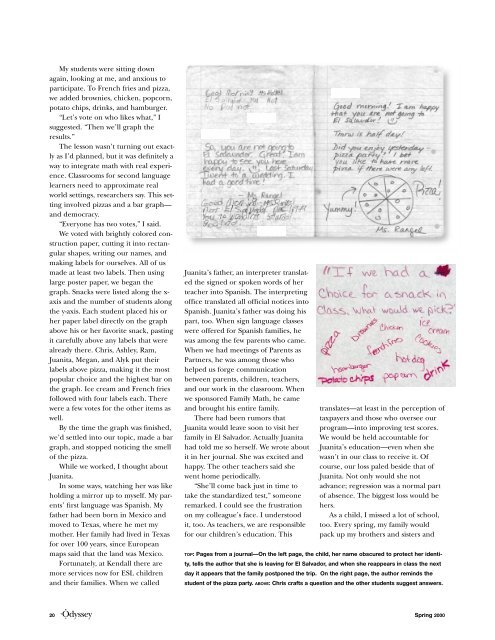Deaf ESL Students - Gallaudet University
Deaf ESL Students - Gallaudet University
Deaf ESL Students - Gallaudet University
Create successful ePaper yourself
Turn your PDF publications into a flip-book with our unique Google optimized e-Paper software.
My students were sitting down<br />
again, looking at me, and anxious to<br />
participate. To French fries and pizza,<br />
we added brownies, chicken, popcorn,<br />
potato chips, drinks, and hamburger.<br />
“Let’s vote on who likes what,” I<br />
suggested. “Then we’ll graph the<br />
results.”<br />
The lesson wasn’t turning out exactly<br />
as I’d planned, but it was definitely a<br />
way to integrate math with real experience.<br />
Classrooms for second language<br />
learners need to approximate real<br />
world settings, researchers say. This setting<br />
involved pizzas and a bar graph—<br />
and democracy.<br />
“Everyone has two votes,” I said.<br />
We voted with brightly colored construction<br />
paper, cutting it into rectangular<br />
shapes, writing our names, and<br />
making labels for ourselves. All of us<br />
made at least two labels. Then using<br />
large poster paper, we began the<br />
graph. Snacks were listed along the xaxis<br />
and the number of students along<br />
the y-axis. Each student placed his or<br />
her paper label directly on the graph<br />
above his or her favorite snack, pasting<br />
it carefully above any labels that were<br />
already there. Chris, Ashley, Ram,<br />
Juanita, Megan, and Alyk put their<br />
labels above pizza, making it the most<br />
popular choice and the highest bar on<br />
the graph. Ice cream and French fries<br />
followed with four labels each. There<br />
were a few votes for the other items as<br />
well.<br />
By the time the graph was finished,<br />
we’d settled into our topic, made a bar<br />
graph, and stopped noticing the smell<br />
of the pizza.<br />
While we worked, I thought about<br />
Juanita.<br />
In some ways, watching her was like<br />
holding a mirror up to myself. My parents’<br />
first language was Spanish. My<br />
father had been born in Mexico and<br />
moved to Texas, where he met my<br />
mother. Her family had lived in Texas<br />
for over 100 years, since European<br />
maps said that the land was Mexico.<br />
Fortunately, at Kendall there are<br />
more services now for <strong>ESL</strong> children<br />
and their families. When we called<br />
Juanita’s father, an interpreter translated<br />
the signed or spoken words of her<br />
teacher into Spanish. The interpreting<br />
office translated all official notices into<br />
Spanish. Juanita’s father was doing his<br />
part, too. When sign language classes<br />
were offered for Spanish families, he<br />
was among the few parents who came.<br />
When we had meetings of Parents as<br />
Partners, he was among those who<br />
helped us forge communication<br />
between parents, children, teachers,<br />
and our work in the classroom. When<br />
we sponsored Family Math, he came<br />
and brought his entire family.<br />
There had been rumors that<br />
Juanita would leave soon to visit her<br />
family in El Salvador. Actually Juanita<br />
had told me so herself. We wrote about<br />
it in her journal. She was excited and<br />
happy. The other teachers said she<br />
went home periodically.<br />
“She’ll come back just in time to<br />
take the standardized test,” someone<br />
remarked. I could see the frustration<br />
on my colleague’s face. I understood<br />
it, too. As teachers, we are responsible<br />
for our children’s education. This<br />
translates—at least in the perception of<br />
taxpayers and those who oversee our<br />
program—into improving test scores.<br />
We would be held accountable for<br />
Juanita’s education—even when she<br />
wasn’t in our class to receive it. Of<br />
course, our loss paled beside that of<br />
Juanita. Not only would she not<br />
advance; regression was a normal part<br />
of absence. The biggest loss would be<br />
hers.<br />
As a child, I missed a lot of school,<br />
too. Every spring, my family would<br />
pack up my brothers and sisters and<br />
TOP: Pages from a journal—On the left page, the child, her name obscured to protect her identity,<br />
tells the author that she is leaving for El Salvador, and when she reappears in class the next<br />
day it appears that the family postponed the trip. On the right page, the author reminds the<br />
student of the pizza party. ABOVE: Chris crafts a question and the other students suggest answers.<br />
20 Spring 2000
















